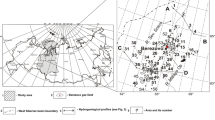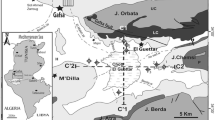Abstract
Tertiary Formations, which are widely spread in the Arab Peninsula, are fundamental to the oil industry in the world’s largest oil producing area. These formations host major aquifers that satisfy water demands for oil production such as steam injection and reservoir pressure maintenance . The current study investigates the hydro-chemical evolution of groundwater in a sequence of Tertiary Formations in Northwest Oman in the Kingdom of Saudi Arabia and the United Arab Emirates borders. Stable isotopes (18O and 2H) show three different groundwater types: (1) groundwater formed from precipitation originating from the Mediterranean Sea, (2) groundwater formed from mixing of northern (Mediterranean) and southern (Indian Ocean) moisture sources, and (3) groundwater affected by evaporation. Radiogenic isotopes 14C and 3H indicate younger groundwater close to the recharge source in North Oman Mountains and older age in the plain desert area that constitutes the discharge zone. Groundwater chemistry notably evolves from Ca–Mg–HCO3 dominant in the recharge area to Na–Cl–SO4 dominant type in the discharge zone. Water–rock interaction is the main process controlling groundwater chemistry in the recharge zone while evaporation becomes progressively effective down the gradient. The geochemistry and stable and radiogenic isotopes of the Tertiary Formations indicate that the study area has witnessed wet periods during the Early Holocene with surface water bodies formed by groundwater discharge at distal parts. The sustainability of such old groundwater that is being exploited for oil production should be thoroughly investigated to secure future oil production.








Similar content being viewed by others
References
Abdalla O, Abri RA, Semhi K, Hosni TA, Amerjeed M, Clark I (2016) Groundwater recharge to ophiolite aquifer in North Oman: constrained by stable isotopes and geochemistry. Environ Earth Sci. doi:10.1007/s12665-016-5887-8
Araguás-Araguás L, Froehlich K, Rozanski K (2000) Deuterium and oxygen-18 isotope composition of precipitation and atmospheric moisture. Hydrol Process 14:1341–1355. doi:10.1002/1099-1085(20000615)14:8<1341:AID-HYP983>3.0.CO;2-Z
Boote DRD, Mou D, White RI (1990) Structural evolution of the Suneinah Foreland, Central Oman Mountains. In: Robertson AHF, Searle MP, Ries AC (eds) The geology of and tectonics of the Oman Region. Geological Society Special Publication No 49, pp 397–418
Clark ID (1988) Ground water resources in the sultanate of Oman; origin, circulation times, recharge processes and paleoclimatology, isotopic and geochemical approaches, Ph.D. thesis. University of Paris-SUD (unpublished)
Clark ID, Fontes J-Ch (1990) Palaeoclimatic reconstruction in northern Oman based on carbonates from hyperalkaline groundwaters. Quat Res 33:320–336
Dergachev VA, Raspopov OM, Damblon F, Jungner H, Zaitseva GI (2007) Natural climate variability during the holocene. Radiocarbon 49(2):837–854
Fleitmann D, Burns SJ, Neff U, Mangini A, Matter A (2003) Changing moisture sources over the last 330,000 years in Northern Oman from fluid-inclusion evidence in speleothems. Quat Res 60:223–232
Forbes GA, Jansen HSM, Schreurs J (2010) Lexicon of Oman subsurface stratigraphy. GeoArabia Special Publication 5
Horst A, Mahlknecht J, Merkel BJ (2007) Estimating groundwater mixing and origin in an overexploited aquifer in Guanajuato, Mexico, using stable isotopes (strontium-87, carbon-13, deuterium and oxygen-18. Isot Environ Health Stud 43(4):323–338
Kwarteng AY, Atsu S, Dorvlo AD, Vijaya Ganiga T, Kumar GT (2009) Analysis of a 27-year rainfall data (1977–2003) in the Sultanate of Oman. Int J Climatol 29:605–617
Macumber PG, Niwas JM, Al Abadi A, Seneviratne R (1997) A new isotopic water line for northern Oman. In: Proceedings of the Third Gulf Water Conference, Muscat 1997, pp 141–162
Makni J, Ben Brahim F, Hassine S, Bouri S, Ben Dhia H (2014) Hydrogeological and mixing process of waters in deep aquifers in arid regions: South East Tunisia. Arab J Geosci 7(2):799–809
Mandel S, Shiftan ZL (1981) Groundwater resources: investigation and development. Academic Press, New York
Matter A, Neubert E, Preusser F, Rosenberg T, Al-Wagdani K (2015) NeuPalaeo-environmental implications derived from lake and sabkha deposits of the southern Rub’al-Khali, Saudi Arabia and Oman. Quat Int. doi:10.1016/j.quaint.2014.12.029
McCarthy KA, McFarland WD, Wilkinson JM, White LD (1992) The dynamic relationship between ground water and the Columbia River: using deuterium and oxygen-18 as tracers. J Hydrol 135:1–12
Ministry of Regional Municipalities & Environment and Water Resources (2005) Provision of technical report for drilling and aquifer testing program in Dakhiliyah-Sharqyah area. Ministry of regional municipalities and water resources, Sultanate of Oman
Nakaya S, Uesugi K, Motodate Y, Ohmiya I, Komiya H, Masuda H, Kusakabe M (2007) Spatial separation of groundwater flow paths from a multi-flow system by a simple mixing model using stable isotopes of oxygen and hydrogen as natural tracers. Water Resour Res. doi:10.1029/2006wr005059
Rizk ZS, Alsharhan AS (1999) Application of natural isotopes for hydrogeologic investigations in United Arab Emirates. In: Proceedings of the 4th Gulf Water Conference, Bahrain, 13–17 February, 1:197–228
Roberts N, Wright HE Jr (1993) Vegetational, lake-level, and climatic history of the Near East and Southwest Asia. Global climates since the last glacial. University of Minnesota Press, Minneapolis, pp 194–220
Weyhenmeyer CE, Burns SJ, Waber HN, Macumber PG, Matter A (2002) Isotope study of moisture sources, recharge areas and groundwater flowpaths within the Eastern Batinah coastal plain, Sultanate of Oman. Water Resour Res 38(1184):2002. doi:10.1029/2000WR000149
Acknowledgements
This research was funded by His Majesty Trusted Research Fund Program under project SR/SCI/ETHS/11/01, Sultan Qaboos University, Oman. The authors would like to thank the staff of Ministry of Regional Municipalities and Water Resources for their support and the staff of the G.G. Hatch Stable Isotope Laboratory (University of Ottawa) for isotopic analysis. We would like to also thank Mrs. Zarqa Yousif for proofreading the manuscript.
Author information
Authors and Affiliations
Corresponding author
Rights and permissions
About this article
Cite this article
Abdalla, O., Al-Abri, R., Semhi, K. et al. Hydro-chemical evolution of groundwater in a sequence of Tertiary Formations in Northwest Oman. Environ Earth Sci 75, 1410 (2016). https://doi.org/10.1007/s12665-016-6196-y
Received:
Accepted:
Published:
DOI: https://doi.org/10.1007/s12665-016-6196-y




